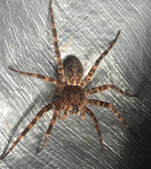 by Jeff Stehm Halloween is approaching and it’s time to consider that ubiquitous symbol of the haunted house – the spider’s web. We often see spiders as scary or a nuisance, and their webs as something that must be brushed away, but in fact spiders and the webs they weave are one of the complex wonders of nature. Dating back almost 400 million years ago, spiders are among the most diverse of terrestrial predators. At least 48,200 spider species, and 120 spider families have been recorded by taxonomists. While we typically associate spiders with webs, not all spiders spin webs (see Wolf Spiders) or use the silk they produce for webs (see Jumping Spiders). Species that produce silk, but not webs, may use silk in several ways: as wrappers for sperm and for fertilized eggs; as a "safety rope"; for nest-building; and as "parachutes" by the young of some species. But webs are what we notice, so let’s learn a bit about web materials, web structure, web functions, and the evolution of webs. Learn more...
1 Comment
Brian Duncan
10/11/2019 09:51:00 am
Jeff - thanks for the information on spiders, interesting. They are amazing creatures and their webs are one of the more ubiquitous things we see every day and often take for granted.
Reply
Your comment will be posted after it is approved.
Leave a Reply. |
Have a blog or blog idea?
Let us know (click) Other Blogs
VA Native Plant Society - click Brenda Clement Jones - click John Muir Laws' Blog - click Megan's Nature Nook - click Categories
All
Archives
September 2023
Blog Administrator:
Kathleen A. VMN since 2018 |
||||||